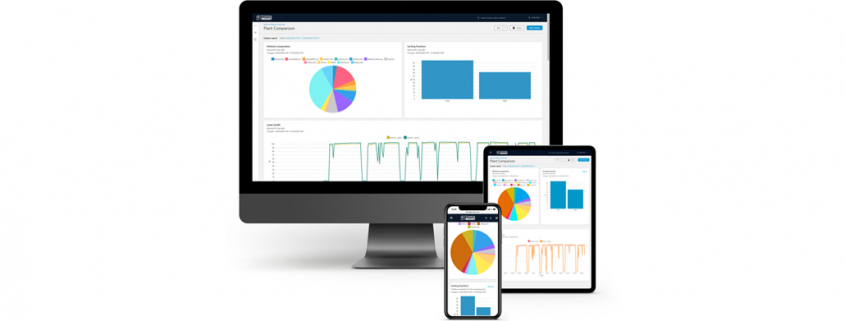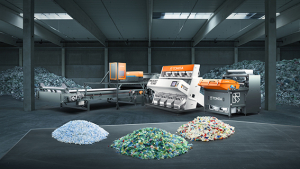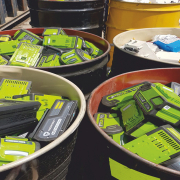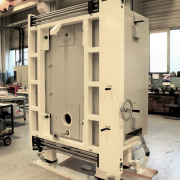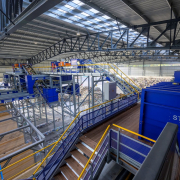Tomra: Triggering Transformation to a more Resource-Friendly Future
The Norwegian multinational collection and sensor-based sorting machine manufacturer TOMRA is engaged to enable a circular economy through smart sorting technologies and close collaboration with its customers around the world.
This applies also to TOMRA Sorting Recycling located in Mülheim-Kärlich (Germany), an important part of the Norwegian parent company, TOMRA. More than 7,400 TOMRA Sorting Recycling systems have been installed in about 100 countries worldwide. These machines support the company’s customers to extract higher-purity fractions from recycling and waste streams, to maximize both yields and profits. GLOBAL RECYCLING talked to Tom Eng, Senior Vice President and Head of TOMRA Sorting Recycling, about the company’s perspective on recent and future trends in the recycling industry including digitalization, Artificial Intelligence and Deep Learning as well as the contribution TOMRA makes to enable the shift to a more sustainable future and a circular economy.
Mr. Eng, 2020 has put digitalization at the forefront of our daily lives. What does digitalization mean for the recycling industry?
I think we should start with a small definition of ‘digitalization’. In a broader perspective, digitalization describes the way analog and physical information is transferred into digital formats. At TOMRA, we refer to digitalization as a process of leveraging digital technologies to turn digital data into valuable knowledge. Using the information collected, fact-based decisions can be made and tangible improvements in both plant performance and business, in general, be realized.
The recycling industry is at the advent of discovering the power of digitalization, ushering in a new era of data-driven process optimization. It opens a new wealth of opportunities as it allows for gathering more information, which in turn, can be evaluated and the respective actions are derived to optimize plant performance. TOMRA Insight for instance allows us to connect to these possibilities. Our cloud-based platform turns optical sorters into connected devices through the generation of valuable data, processing it into actionable information. Data is accessible whenever you want and wherever you are, making it easy to follow up on the sorting performance and adjust settings if necessary. When considering the current global pandemic, digitalization has taken on a whole new meaning and accelerates the transformation to a better-connected industry, smarter and more efficient operations.
How widespread is the use of digital approaches in the industry?
Those at the forefront of today’s sorting and recycling technology are already using the latest technology to realize higher and more stable sorting performances, but these are exceptions rather than a rule. Compared to other industries, digitalization in recycling is still in its infancy. To further advance the case, the respective infrastructures must be set up and scalable, global and impactful solutions be developed and implemented. Here, collaboration across sectors and industries is essential. TOMRA is working diligently to help create an ecosystem of partners to deliver effective and efficient solutions. A good example of our commitment to cross-value-chain collaboration is the creation of our Circular Economy Division in 2019, which actively accelerates the transition to a circular economy and investigates future solutions.
TOMRA’s machines incorporate the latest technologies. Where do you see the biggest advancements made in recent times?
Plant operators and recyclers are exposed to handling ever-changing waste streams. In response to this, the solutions required are increasingly based on the use of Artificial Intelligence and its subset called Deep Learning. Whereas Classical Machine Learning requires feature engineering, Deep Learning draws from vast amounts of data to ‘learn’ how to complete a specified task, allowing the machine to sort complex fractions for which a solution previously did not exist. Moreover, optical sorting technology using robotic ‘arms’ as an alternative to classical valve blocks to eject materials is creating a buzz in the industry. We are undertaking further investigations in this field and will continue to focus on enhancing detection methods.
In whichever form AI is employed, recyclers and plant operators harnessing its potential have a better opportunity to increase circuit automation, reduce manual labor, lower operating cost, improve sorting consistency and elevate safety.
How does TOMRA employ Artificial Intelligence and Deep Learning?
Optical sensors in circuits have employed AI algorithms to sort material for over 30 years and so do ours. Only in 2019, we officially introduced GAIN, a deep learning-based sorting add-on for our AUTOSORT® machines. The first version of GAIN has been trained to eject silicone cartridges from PE-streams allowing for a heightened purification of the sorting result. Unlike common marketed sorting technology, TOMRA offers a combination of Deep Learning and RGB color cameras as well as NIR spectroscopy sensors. This is indeed a unique advantage and contributes to delivering the best classification and detection results in complex applications. Having closely worked with customers and partners, we have extended our deep learning-based application portfolio and look forward to officially sharing it with the market in due time.
Last year, TOMRA introduced the new generation of AUTOSORT®. In how far does the machine differ from previous versions?
We introduced the first version of our AUTOSORT® in 1996. Since then, it has always been our flagship and has undergone years of optimization. With the latest update launched in 2020, the unit incorporates SHARP EYE and a new generation of FLYING BEAM® as standard. SHARP EYE increases light efficiency, enhances sorting precision and improves the separation of difficult to target fractions. FLYING BEAM®, the illumination unit positioned inside the scanner box, guarantees a homogenous light distribution across the entire conveyor belt, thus leading to better detection of materials and consistent sorting performance. The integrated use of both technologies enables AUTOSORT® to consistently deliver high performance in terms of sorting accuracy across all target fractions – even in the most complex of applications. Optionally available are DEEP LAISER®, the first fully integrated deep learning system on the market for excellent object recognition.
AUTOSORT® is used for various applications. Are flake sorting applications among these?
Flake sorting is another important pillar of our product range, for which we offer dedicated high-performing machines, namely AUTOSORT® FLAKE and INNOSORT FLAKE. While AUTOSORT® FLAKE is our high-end polymer flake sorter used when quality demands are high and contamination levels are low, INNOSORT FLAKE sorts more contaminated flakes as small as two millimeters by both color and material and is more flexible in its set-up. Unique in the market, we offer our customers a ‘one-stop shop’ solution consisting of our AUTOSORT® for bottle
sorting and one of our flake sorters for subsequent flake purification. This integrated approach paves the way to cleaner end products and recycled PET and PO resin, which are increasingly asked for in the market. Especially recycled food-grade PP will be high in demand in the future, but due to the technological burden to separate food-grade PP from non-food-grade PP, supply is still short. To further promote this, TOMRA has joined a consortium of various experts to find identification technologies to generate food-grade PP compliant with the necessary regulations and approved for being used for food packaging.
Apart from technologies, which general advancements can you anticipate for the industry in the long-term?
The recycling industry is a very dynamic one. Responding to the global waste crisis as well as market and consumer demands, global efforts that emerged in recent years have produced a tidal wave of new agendas, collaborations and legislations catalyzing the transition to a more sustainable future. Brand owners for instance will experience a completely different ownership by designing products for recycling and fulfilling the demands of Extended Producer Responsibility concepts, which are increasingly gaining ground to reduce waste generation and improve recycling rates. Moreover, products might be equipped with watermarks or digital codes to allow for traceability, and waste management infrastructures will be built in developing countries to reduce the amount of waste and close the loop. The waste hierarchy, a set of priorities for the efficient use of resources including the three R’s (reduce, reuse, recycle), will further guide us in the transition to a more resource-friendly future. Although each component has a crucial role to play, we see the most potential in advanced mechanical recycling, the full capabilities of which have yet to be explored and demonstrated by the support of collaboration and targeted investments. What we’d like to see in the future and actively contribute to is that waste of one company becomes resource of another and that recycled products (rPE, rPP, rPET) are used in preference to virgin materials – a scenario that should become commonplace.
Which role do you assign to TOMRA in support of these developments?
In our position as leading provider of sorting technology and industry pioneer with decades of proven field experience, we take responsibility within the value chain, closely work with our partners and customers as well as other stakeholders to support the creation of necessary waste management infrastructures and jointly develop forward-thinking solutions. A good example of this is our pilot plant for post-consumer plastic waste sorting and advanced mechanical recycling we are operating together with Borealis and Zimmerman Recycling. Besides, we use our memberships in organizations such as the Alliance to End Plastic Waste, the New Plastics Economy, Nextloopp and many more to share our industry knowledge with other industry pioneers to jointly accelerate the transition to a greener future in which resources never becomes waste.
To conclude, we are optimistic about the future and will continue to harness the combined power of smart, data-driven technology and collaboration – the trigger for transformation.
www.tomra.com/en/sorting/recycling
(Published in GLOBAL RECYCLING Magazine 1/2021, Page 15, Photo: TOMRA)

